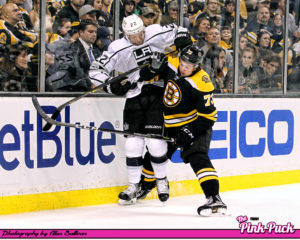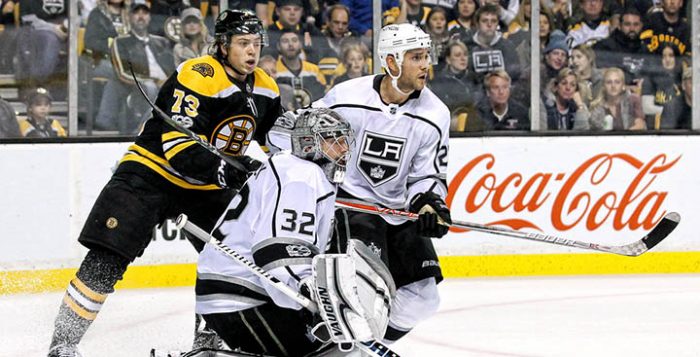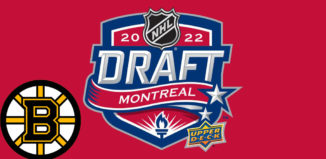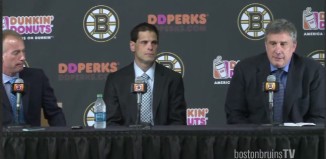McAvoy Continues to Follow Concussion Protocol
(Photo: Alan Sullivan)
On Saturday night, December 1, 2018, Boston Bruins defenseman Charlie McAvoy met with media to discuss his health and his progress since being diagnosed with a concussion. He had recently begun to get back on the ice and obviously everyone, including himself, is anxious for his return to the lineup.
The Bruins are no stranger to players with concussion and have a solid protocol in place. Unlike other injuries that involve bones, muscles, and ligaments, there is no set timetable for when a player may be ready to get back into a game when they are recovering from a concussion.
Unlike many players who end up concussed, there was no dirty hit to McAvoy’s head or a hit from behind that threw him into the boards. And he certainly didn’t lose consciousness while on the ice during a game.
“I know that after that game in Edmonton [October 18, 2018], following that game was when I spoke to the trainers and the doctors, and that was when we made the decision to come back to Boston and get it looked at further,” McAvoy said.
This is the first concussion that McAvoy has had and, as such, he wasn’t prepared for the symptoms he was experiencing and perhaps as a result was a little unsure as well as frustrated with how his body was responding.
 “Well, it’s been an experience for me, for sure, going through it for the first time, kind of learning more about it as I go,” McAvoy explained. “Unfortunately, I would have loved to have not gone through it, but nonetheless, it’s been an experience for me, and I’m learning a lot of valuable things.”
“Well, it’s been an experience for me, for sure, going through it for the first time, kind of learning more about it as I go,” McAvoy explained. “Unfortunately, I would have loved to have not gone through it, but nonetheless, it’s been an experience for me, and I’m learning a lot of valuable things.”
One of the symptoms that was obvious for McAvoy was a vestibular issue that was affecting his balance. There had been speculation by some out of the loop that perhaps he had vertigo. However, it has now been confirmed that the vestibular issues are a result of the concussion.
“You get a hit like this, and it’s able to really throw you off in that regard, and you get a concussion. As far as vestibular goes, it’s really kind of reteaching your brain to handle certain activities that can bring on certain symptoms, like dizziness or kind of feeling out of it, stuff like that. So, this is basically that concussion rehab that I alluded to, reintroducing these things to my brain. Actually, one of the things I heard is my brain is out of shape. So, it’s kind of teaching those things, reintroducing them, and things are going well right now,” he said.
“My brain is out of shape.” — Charlie McAvoy
Because there is no set timetable when recovering from a concussion, perhaps the hardest thing for the patient—especially a hockey player who is used to certain things like exercise, skating, playing the game, and interacting with his teammates—is the need to take recovery one day at a time, which can feel like an eternity. But patience is critical in order to give the brain all the time it needs to heal.
“It’s a lot, and at times, it can really consume you. Being my first time going through it, I’ve felt certain emotions with it, and it’s really tough, but I’m very fortunate to have such a good support system. Obviously, my family, they’re always there for me, but just the pointers I’ve gotten from guys like [Patrice Bergeron] and other guys on the team that have gone through concussions—Don Sweeney and all of the trainers and the doctors, they’ve kept me in great spirits, kind of acknowledging that it’s my first time, and a lot of this stuff is new to me. But it’s been an educational process for me. Things are going really well, and I’m so excited to get back with the team,” McAvoy described.
 While the defenseman would certainly have preferred not to have gotten the concussion, he understands that the physicality of hockey does make the possibility of injury more likely. Of course, this doesn’t mean that head shots should just be expected and accepted in the game. Nor does he believe that he can prevent such injuries.
While the defenseman would certainly have preferred not to have gotten the concussion, he understands that the physicality of hockey does make the possibility of injury more likely. Of course, this doesn’t mean that head shots should just be expected and accepted in the game. Nor does he believe that he can prevent such injuries.
“It’s the game we play. It’s the best game in the world and I wouldn’t trade playing this game and playing in this league for anything. This is my dream, and I think that these things tend to happen. It’s just like my knee last year; these things happen. It’s a game, unfortunately, where sometimes you can’t avoid injury, but I think with the style of play I have, hopefully avoiding injury is something I’ll be able to do here in the future,” he answered.
Perhaps the most important take away with regard to the young 2016 first round pick (14th overall)—after all he is only 20 years old—is that there is a concussion protocol that identifies the brain injury and then helps the player to recover. Had this happened a few years ago, it is very possible that given the symptoms he has been displaying, especially the vestibular issues, it could very well have signaled the end to his career. While some may argue that it is sad that there even has to be a concussion protocol, in McAvoy’s case, his ability to return to the game he loves and the career he has worked so hard to attain is because of this better understanding of such brain injuries.














